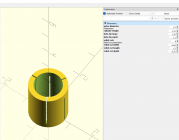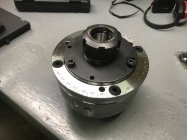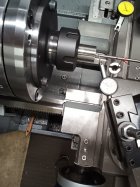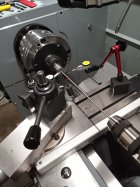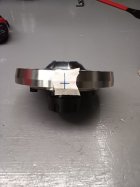BuffaloBill
Silver $$ Contributor
I ordered a TBAS Monday night and it’s already here (Thursday afternoon)!
The initial setup portion of the instruction manual discusses using a lesser torque (10-15lbft) for the radial adjustment screws, before a chuck is mounted to the radial plate. After a chuck is mounted, the radial adjustment are torqued to 25-35lbft in use. That makes sense to me; a big beefy chuck bolted on there will greatly stiffen that radial plate, allowing a greater screw torque for a given amount of plate deflection, etc.
The ER-50 chuck I’m waiting for has an 18mm thick mounting flange. This would add some stiffness but not as much as a chuck body’s 2-3” thickness or beam height. Perhaps an upper torque limit of 20-25lbft would be appropriate? Intuitively I wouldn’t think much torque would be required to solidify this system for prevention of chatter with the light cuts I’d typically be taking. But I don’t know that for certain.
Any of you material/stress analysis people want to offer an opinion? I didn’t measure screw thread pitch or take the radial plate off to see what sort of beam dimensions remain after the lightening cuts were made on this V3 version.
I can call or email Nate to get his advice on this but thought others here may be interested in an ER50 setup, and would perhaps chime in.
The weight of this TBAS with a D1-6 mount, but without the ER-50 chuck, feels very similar to my 9” 3-jaw. I use wooden cradles that sit on the carriage arms, positioning the chucks at the right height, to make installing them less strenuous and more controlled. I’ll make one custom for this TBAS as the diameters of the axial & radial plates are different which causes it to sit at an angle in my existing wooden cradles.
The initial setup portion of the instruction manual discusses using a lesser torque (10-15lbft) for the radial adjustment screws, before a chuck is mounted to the radial plate. After a chuck is mounted, the radial adjustment are torqued to 25-35lbft in use. That makes sense to me; a big beefy chuck bolted on there will greatly stiffen that radial plate, allowing a greater screw torque for a given amount of plate deflection, etc.
The ER-50 chuck I’m waiting for has an 18mm thick mounting flange. This would add some stiffness but not as much as a chuck body’s 2-3” thickness or beam height. Perhaps an upper torque limit of 20-25lbft would be appropriate? Intuitively I wouldn’t think much torque would be required to solidify this system for prevention of chatter with the light cuts I’d typically be taking. But I don’t know that for certain.
Any of you material/stress analysis people want to offer an opinion? I didn’t measure screw thread pitch or take the radial plate off to see what sort of beam dimensions remain after the lightening cuts were made on this V3 version.
I can call or email Nate to get his advice on this but thought others here may be interested in an ER50 setup, and would perhaps chime in.
The weight of this TBAS with a D1-6 mount, but without the ER-50 chuck, feels very similar to my 9” 3-jaw. I use wooden cradles that sit on the carriage arms, positioning the chucks at the right height, to make installing them less strenuous and more controlled. I’ll make one custom for this TBAS as the diameters of the axial & radial plates are different which causes it to sit at an angle in my existing wooden cradles.
Last edited:










